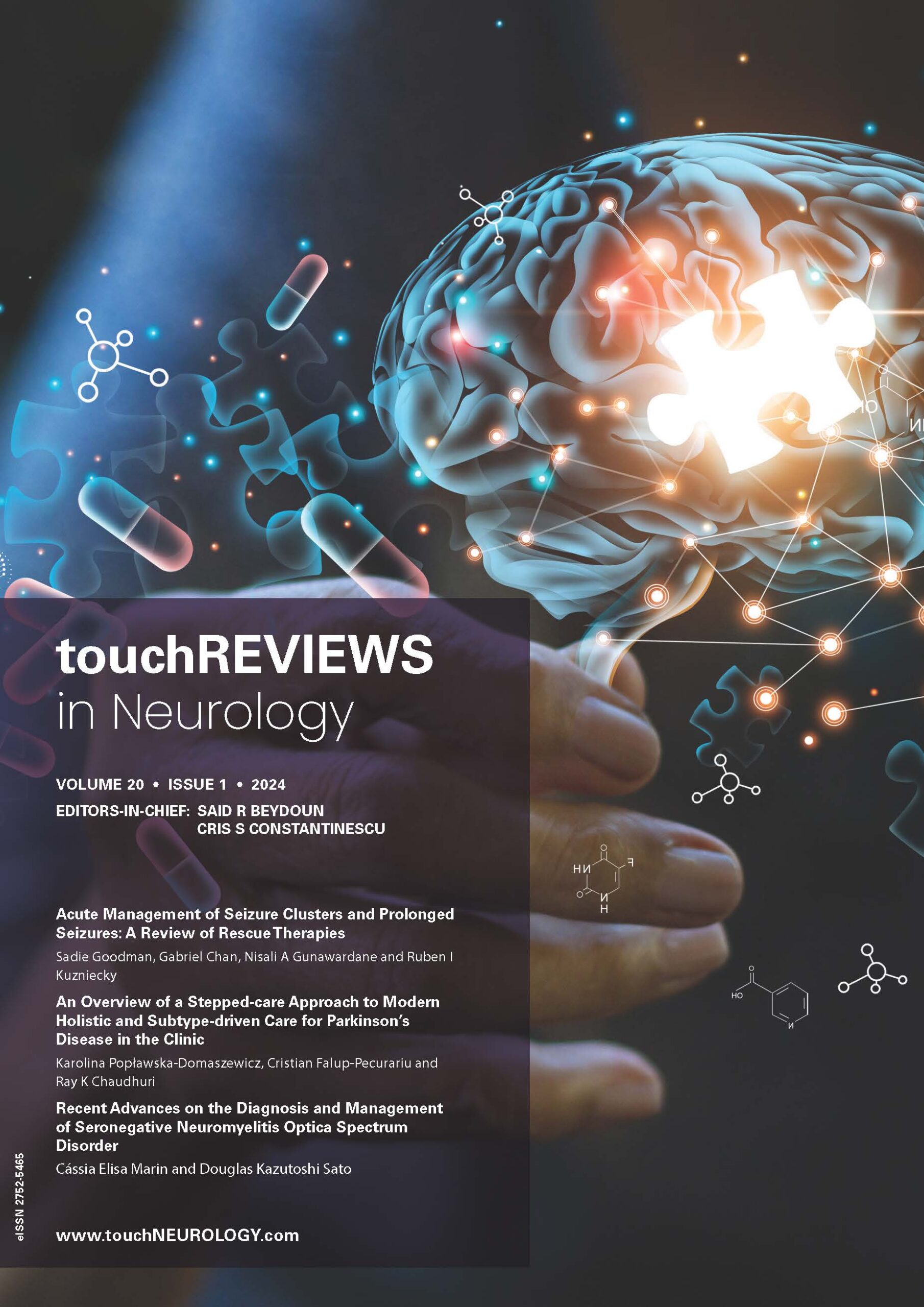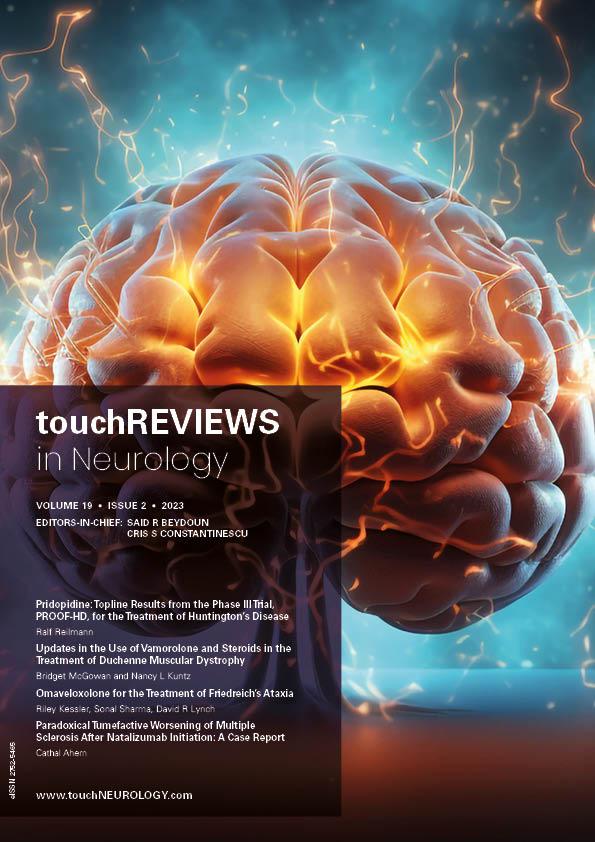US NEUROLOGY – VOLUME 12 ISSUE 1 – SPRING 2016
It is with great pleasure that I introduce the spring edition of US Neurology. We open this edition with a foreword from Ruben Kuzniecky, who nicely summarizes the journal content. This edition includes topical reviews and editorials in areas such as Duchenne muscular dystrophy, multiple sclerosis, and neurocognitive complications of cancer and cancer therapies. We are currently looking forward to the AAN meeting in April, where you can find the journal available on the AAN literature stand.
We would like to thank all our expert authors and reviewers for all their hard work, and a special thank you goes to our esteemed Editorial Board for their continued support. We hope you enjoy this edition of US Neurology, and that it serves as a useful tool to your practice and interests.
We welcome any feedback or pre-submission enquiries you may have.
Welcome to the latest edition of US Neurology, which features a wide range of topical articles covering numerous areas of neurology that are of interest to the wider biomedical community. In this edition, we discuss treatment of Duchene Muscular Dystrophy (DMD), differential diagnosis of multifocal motor neuropathy, issues of care in multiple sclerosis and other […]
Neuromuscular Disorders
Duchenne muscular dystrophy (DMD) is an X-linked disorder affecting one in 5,000 live male births which makes it the most common and most severe form of muscular dystrophy.1 The absence of the protein dystrophin leads to symptom onset typically between the ages of two to five years, with abnormal gait and frequent falls being hallmark […]
Myelopathy is a common diagnosis often made by clinical neurologists and can be a cause of significant disability. Differential diagnosis classically includes structural etiology, demyelinating, metabolic, nutritional, inherited, and degenerative causes, resulting in a vast array of pathophysiologic processes, underlying myelopathy (Table 1). It is critical that clinicians use their clinical knowledge and utilize appropriate […]
In my avocation as a home cook, I found interesting a passage in Fuchsia Dunlop’s Shark’s Fins and Sichuan Pepper, a memoir of the author’s culinary journey in China.1 She describes an elderly gourmet’s lament for the rising dominance of culinary school education over traditional chefs’ apprenticeships. He was dismayed by the substitution of mass-produced […]
Multiple Sclerosis
Of the 400,000 adults living with multiple sclerosis (MS) in the US, an estimated 30% are between the age of 55–64 years and nearly 15% are 65 years of age or older.1 There is additional evidence of a shift in the peak prevalence of MS among older age groups. For example, the peak prevalence of […]
Multiple sclerosis (MS) is a lifelong neurologic disease affecting the central nervous system and resulting in demyelination and axonal loss over time. Symptoms are widely variable and often involve motor and sensory impairment, vision loss, gait disturbance, cognitive dysfunction, and fatigue. Furthermore, MS is a disease common to women of childbearing age, with 70% of […]
Vestibular Migraine
Population based studies show that primary headaches, such as migraine, are very common disorders.1 Similar accounts to vertigo and dizziness, which are are also symptoms frequently complained of.2 A significant proportion of patients report suffering these symptoms (headache, dizziness and/or vertigo) simultaneously and independently of each other. This especially accounts for migraine since up to […]
Cognitive Dysfunction
Neurocognitive function is commonly compromised in cancer patients. While symptoms can be caused by the tumor itself and are commonly seen in patients with brain tumors, the etiology of neurocognitive deficits is much more complex in patients treated for tumors outside the nervous system. Impaired cognition can be present in cancer patients prior to treatment; […]
European Neurological Review Highlights
There is increasing evidence that vitamin D status is associated with both the development of multiple sclerosis (MS) and also the modulation of disease activity and possibly progression. Several publications have reported that the risk of MS is higher in patients with low vitamin D intake or serum 25-hydroxyvitamin D (25[OH]D) levels, for example due […]
Vitamin D is an essential nutrient for bone homeostasis that has also been implicated in numerous other disorders, such as cardiovascular disease (CVD) and autoimmune diseases. Originally vitamin D deficiency was associated only with rickets and it was considered that the fortification of food resolved this disorder. However, it is now realised that rickets represents […]
Selective attention is defined as the preferential allocation of cognitive and neural resources to a specific event that has become behaviourally relevant.1 Attention is a prerequisite to all cognitive tasks and learning. It involves many brain structures grouped into the so-called attentional matrix. Migraine is frequent and occurs in as high as a quarter of […]

Trending Topic
The surge in social media use seems to have become a sign of our times. Social media has ramified into not only our personal lives but, importantly, also our professional lives and will continue to do so in the future.1–4 At the same time, more neurologists resorted to online learning modalities, including podcasts and social media […]
Journal Archive
touchREVIEWS in Neurology is a peer-reviewed, free-to-access, bi-annual neurology journal comprising review articles, case reports, practice guides, theoretical discussions, and original research. It features balanced and comprehensive articles written by leading authorities, addressing the most important and salient developments in the field of neurology.
Latest articles videos and clinical updates - straight to your inbox
Log into your Touch Account
Earn and track your CME credits on the go, save articles for later, and follow the latest congress coverage.
Register now for FREE Access
Register for free to hear about the latest expert-led education, peer-reviewed articles, conference highlights, and innovative CME activities.
Sign up with an Email
Or use a Social Account.
This Functionality is for
Members Only
Explore the latest in medical education and stay current in your field. Create a free account to track your learning.
















